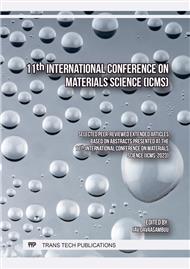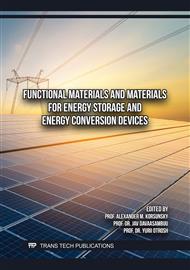[1]
K. Turcheniuk, D. Bondarev, V. Singhal, G. Yushin, Ten years left to redesign lithium-ion batteries, Nature, 559 (2018) 467-470.
DOI: 10.1038/d41586-018-05752-3
Google Scholar
[2]
J.B. Goodenough, Energy storage materials: A perspective, Energy Stor. Mater, 1 (2015) 158-161.
Google Scholar
[3]
Y.L. Liang, Z.L. Tao, J. Chen, Organic electrode materials for rechargeable lithium batteries, Adv. Energy. Mater, 7 (2012) 742-769.
DOI: 10.1002/aenm.201100795
Google Scholar
[4]
P. Poizot, F. Dolhem, Clean energy new deal for a sustainable world: from non-CO2 generating energy sources to greener electrochemical storage devices, Energy Environ. Sci, 6 (2011) 2003-2019.
DOI: 10.1039/c0ee00731e
Google Scholar
[5]
T. Janoschka, M.T. Hager, U.S. Schubert, Powering up the future: radical polymers for battery applications, Adv. Mater, 24 (2012) 6397–6409.
DOI: 10.1002/adma.201203119
Google Scholar
[6]
L.D. Xing, X.W. Zheng, M. Schroeder, J. Alvarado, A.V.W. Cresce, K Xu, Q.S Li, W.S Li, Deciphering the ethylene carbonate–propylene carbonate mystery in Li-ion batteries, Acc. Chem. Res, 2 (2018) 282−289.
DOI: 10.1021/acs.accounts.7b00474
Google Scholar
[7]
L. Zhao, W.K. Wang, A.B. Wang, Z.B. Yu, S. Chen, Y.S. Yang, A novel MC/AQ parasitic composite as cathode material for lithium battery, Funct. Mater, 42 (2011)1312-1315.
Google Scholar
[8]
Y.C. Sun, A. Bolag, H. Altaa, J. Ning, T. Bao, T Ojiyed, Preparation of anthraquinone/molecular sieve composites and their application in lithium-ion batteries, Inner Mongolia Petrochemical Industry, 1 (2023) 5-12.
Google Scholar
[9]
Z.P. Song, Y.M. Qian, L. Mikhail, Gordin, D.H. Tang, T. Xu, M. Otani, H. Zhan, H.S. Zhou, D.H. Wang, Polyanthraquinone as a reliable organic electrode for stable and fast lithium storage, Angew. Chem. Int. Ed. Commun., 47 (2015) 13947 –13951.
DOI: 10.1002/anie.201506673
Google Scholar
[10]
J.X. Yang, Z.P. Wang, Y.Q. Shi, Poorly soluble 2,6-dimethoxy-9,10-anthraquinone cathode for lithium-ion batteries: The role of electrolyte concentration, ACS Appl. Mater. Interfaces, 12 (2020) 7179-7185.
DOI: 10.1021/acsami.9b19623
Google Scholar
[11]
Y.L. Liang, P. Zhang, J. Chen, Function-oriented design of conjugated carbonyl compound electrodes for high energy lithium batteries, Chem. Sci, 4 (2013) 1330-1337.
DOI: 10.1039/c3sc22093a
Google Scholar
[12]
M.L. Tang, Z.N. Bao, Halogenated materials as organic semiconductors, Chem. Mater, 23 (2011) 446-455.
Google Scholar
[13]
Y.S. Zhang, I. Murtaza, D. Liu, R. Tan, Y.A. Zhu, H. Meng, Understanding the mechanism of improvement in practical specific capacity using halogen substituted anthraquinones as cathode materials in lithium batteries, Electrochim. Acta, 224 (2017) 622–627.
DOI: 10.1016/j.electacta.2016.12.065
Google Scholar
[14]
Ch.V. Reddy, I.N. Reddy, K. Ravindranadh, K.R. Reddy, J. Shim, B. Cheolho, Au-doped BiVO4 nanostructure-based photoanode with enhanced photoelectrochemical solar water splitting and electrochemical energy storage ability, Applied Surface Science, 545 (2021) 149030.
DOI: 10.1016/j.apsusc.2021.149030
Google Scholar



